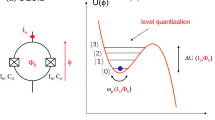Abstract
We study the optimal quantum control of heteronuclear two-qubit systems described by a Hamiltonian containing both nonlocal internal drift and local control terms. We derive an explicit formula to compute the minimum time required to steer the system from an initial state to a specified final state. As applications the minimal time to implement Controlled-NOT gate, SWAP gate and Controlled-U gate is calculated in detail. The experimental realizations of these quantum gates are explicitly presented.
Similar content being viewed by others
References
Warren W, Rabitz H, Dahleb M. Coherent control of quantum dynamics: The dream is alive. Science, 1993, 259: 1581–1589
Rabitz H, de Vivie-Riedle R, Motzkus M, et al. Whither the future of controlling quantum phenomena? Science, 2000, 288: 824–828
Daniel C, Full J, Gonzàlez L, et al. Deciphering the reaction dynamics underlying optimal control laser fields. Science, 2003, 299: 536–539
Nielsen M A, Chuang I L. Quantum Computation and Quantum Information. Cambridge: Cambridge University Press, 2000
Ernst R R, Bodenhausen G, Wokaun A. Principles of Nuclear Magnetic Resonance in One and Two Dimensions. Oxford: Oxford University Press, 1987
Gershenfeld N A, Chuang I L. Bulk spin-resonance quantum computation. Science, 1997, 275: 350–356; Cory D G, Fahmy A, Havel T. Ensemble quantum computing by NMR spectroscopy. Proc Natl Acad Sci USA, 1997, 94: 1634–1639
Lapert M, Salomon J, Sugny D. Time-optimal monotonically convergent algorithm with an application to the control of spin systems. Phys Rev A, 2012, 85: 033406
Tibbetts K W M, Brif C, Grace M D, et al. Exploring the tradeoff between fidelity and time optimal control of quantum unitary transformations. Phys Rev A, 2012, 86: 062309
Motzoi F, Gambetta J M, Merkel S T, et al. Optimal control methods for rapidly time-varying Hamiltonians. Phys Rev A, 2011, 84: 022307
Assémat E, Lapert M, Zhang Y, et al. Simultaneous time-optimal control of the inversion of two spin-1/2 particles. Phys Rev A, 2010, 82: 013415
Lapert M, Zhang Y, Braun M, et al. Singular extremals for the timeoptimal control of dissipative spin 1/2 particles. Phys Rev Lett, 2010, 104: 083001
Khaneja N, Brockett R, Glaser S J. Time optimal control in spin systems. Phys Rev A, 2001, 63: 032308
Makhlin Y. Nonlocal properties of two-qubit gates and mixed states, and the optimization of quantum computations. Quant Inf Proc, 2002, 1: 243–252
Zhang J, Vala J, Sastry S, et al. Geometric theory of nonlocal two-qubit operations. Phys Rev A, 2003, 67: 042313
Glaser J, Schulte-Herbrüggen T, Sieveking M, et al. Unitary control in quantum ensembles: Maximizing signal intensity in coherent spectroscopy. Science, 1998, 280: 421–424
Author information
Authors and Affiliations
Corresponding author
Rights and permissions
About this article
Cite this article
Li, B., Yu, Z., Fei, S. et al. Time optimal quantum control of two-qubit systems. Sci. China Phys. Mech. Astron. 56, 2116–2121 (2013). https://doi.org/10.1007/s11433-013-5325-9
Received:
Accepted:
Published:
Issue Date:
DOI: https://doi.org/10.1007/s11433-013-5325-9




